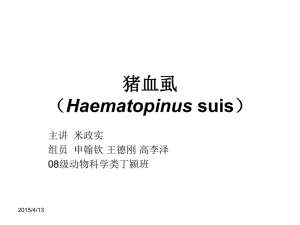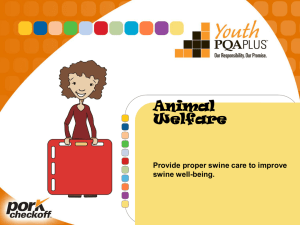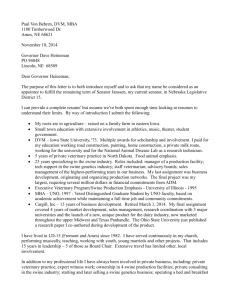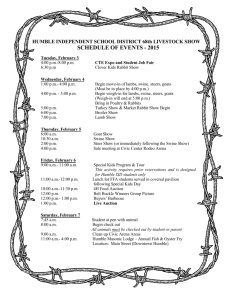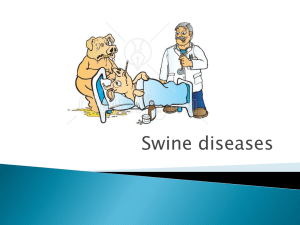Chapter 15 (Biology and Diseases of Swine)
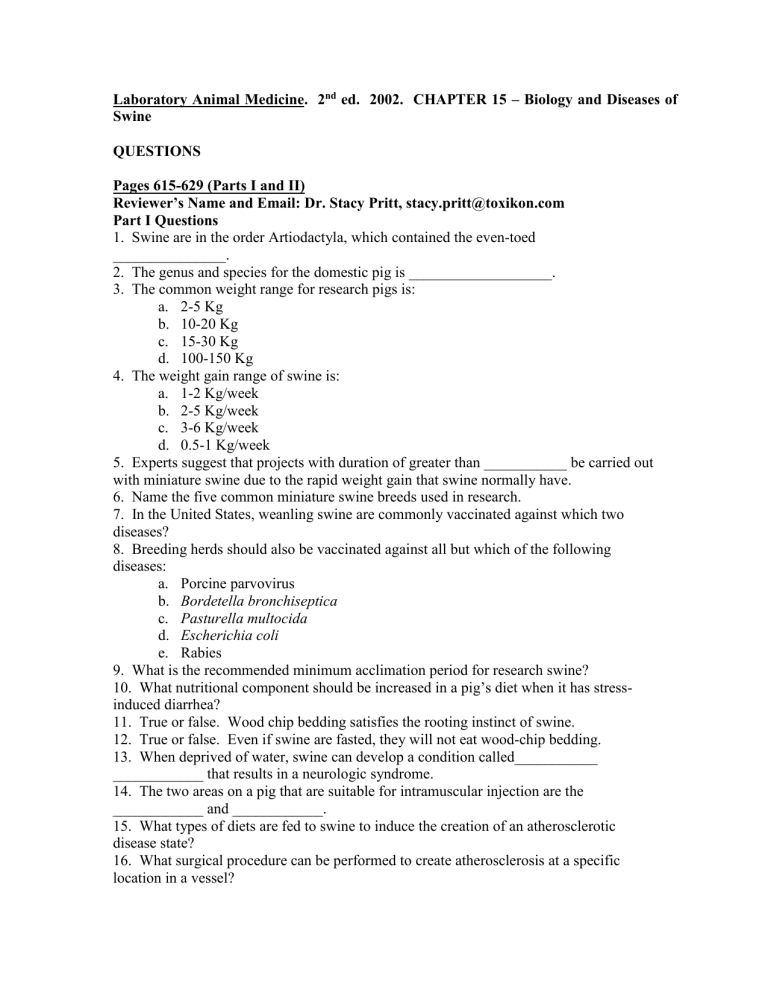
Laboratory Animal Medicine. 2 nd ed. 2002. CHAPTER 15 – Biology and Diseases of
Swine
QUESTIONS
Pages 615-629 (Parts I and II)
Reviewer’s Name and Email: Dr. Stacy Pritt, stacy.pritt@toxikon.com
Part I Questions
1. Swine are in the order Artiodactyla, which contained the even-toed
_______________.
2. The genus and species for the domestic pig is ___________________.
3. The common weight range for research pigs is: a.
2-5 Kg b.
10-20 Kg c.
15-30 Kg d.
100-150 Kg
4. The weight gain range of swine is: a.
1-2 Kg/week b.
2-5 Kg/week c.
3-6 Kg/week d.
0.5-1 Kg/week
5. Experts suggest that projects with duration of greater than ___________ be carried out with miniature swine due to the rapid weight gain that swine normally have.
6. Name the five common miniature swine breeds used in research.
7. In the United States, weanling swine are commonly vaccinated against which two diseases?
8. Breeding herds should also be vaccinated against all but which of the following diseases: a.
Porcine parvovirus b.
Bordetella bronchiseptica c.
Pasturella multocida d.
Escherichia coli e.
Rabies
9. What is the recommended minimum acclimation period for research swine?
10. What nutritional component should be increased in a pig’s diet when it has stressinduced diarrhea?
11. True or false. Wood chip bedding satisfies the rooting instinct of swine.
12. True or false. Even if swine are fasted, they will not eat wood-chip bedding.
13. When deprived of water, swine can develop a condition called___________
____________ that results in a neurologic syndrome.
14. The two areas on a pig that are suitable for intramuscular injection are the
____________ and ____________.
15. What types of diets are fed to swine to induce the creation of an atherosclerotic disease state?
16. What surgical procedure can be performed to create atherosclerosis at a specific location in a vessel?
17. Pigs make a genetic model for which of the following heart defects? a.
High membranous ventricular septal defect b.
Mitral valve prolapse c.
Coarctation of the aorta d.
Transposition of the great vessels
18. Pigs make a genetic model for which of the following coagulopathies: a.
Hemophilia (lack of Factor 8) b.
DIC c.
Thrombocytopenia d.
Von Willebrand’s disease
19. The anatomical and physiological characteristics of porcine skin make it a definitive model for ________________ surgery.
20. Transplants of which organs have been performed in swine?
Part II Questions
1. What two characteristics of the swine coronary anatomy make them similar to 90% of the human population?
2. The pig stomach has a muscular outpouching, near the pylorus, called the
_________________.
3. The majority of the large intestines are in the spiral colon, which is in the
_____________ _________________quadrant of the abdomen.
4. Which of the following choices represents all of the accessory sex organs of boars? a.
Prostate, vesicular gland b.
Ductus deferens, prostate, vesicular gland c.
Ductus deferens, prostate, vesicular gland, bulbourethral gland d.
Ductus deferens, prostate, bulbourethral gland
5. Why do small breeds of swine require fixed-quantity feedings?
6. Diets for minim and micro breeds have lower ______________ and higher
___________ concentrations compared to the food for farm pigs.
7. Female milk is low in which element?
8. Piglets may get additional amounts of this element if provided access to what?
9. Litter size is the smallest at which parity? a.
1st b.
2nd c.
3rd d.
4th
10. The gestation length in swine is: a.
110-111 days b.
99-100 days c.
114-115 days d.
120-121 days
11. Piglets need to be kept at the following temperature range (at pig level) for the first 3 to 4 weeks of life to prevent hypothermia: a.
70-80ºF b.
85-90ºF c.
90-95ºF
d.
95-100ºF
12. True or false. The eyesight of swine is considered poor.
13. Why is swine immunology of such interest in laboratory animal medicine?
14. The cortical and medullary areas of porcine lymph nodes are ___________, as well as in elephants, rhinos, dolphins, hippos and warthogs.
15. Swine have two different types of Peyer’s patches. One type is located on the
______________ (having both B and T cells) and the other on the ____________(having
B cells almost exclusively).
16. By what action does monoclonal antiporcine D3 antibody create in vivo tolerance for xenotransplantation.
17. Porcine bone marrow is more similar to people than rodents in the toxicity response to lethal ___________.
18. True or false. Swine have a lymphocyte subset that expresses both CD4 and CD8, a characteristic shared by several other species.
19. There is no transplacental transfer of maternal immunity, making the piglets entirely
____________ dependent for immunity during the first 24 to 48 hours of life.
20. Swine colostrum is rich in which type of immunoglobulin? a.
IgA b.
IgE c.
IgG d.
IgM
21. What are the main leukocytes found in porcine colostrum?
22. Intestinal closure for the absorption of colostrums ends when?
23. Swine lack the gene for IgD, which is a precursor to _________.
24. SLA stands for __________ ________________ ____________, which is equivalent to the major histocompatibility complex.
25. The gene for the SLA is located on which chromosome?
26. Antigen-antibody complexes are eliminated through the ________ in pigs. a.
Lungs b.
Liver c.
Spleen d.
Kidneys
27. How many blood factors do pigs have?
28. A researcher can induce an immunodeficiency which removal of which two organs in pigs?
29. The hemolytic disease in neonates related to postnatal absorption of maternal antibodies is called____________________ _______________.
30. An inherited form of glomerulonephritis is found in which breed of pigs? a.
Mini-pig Yucatans b.
Gottingen mini-pigs c.
Norwegian Yorkshires d.
Great Whites
31. A spontaneous IgA nephropathy has been identified in slaughter pigs from which country?
32. Two infectious causes of arthritis in swine are ____________________ and
________________.
33. These two causative organisms of arthritis in Question 32 have a similar pathogenesis to what human disease?
34. True or false. Matching SLA skin grafts typically survive for only 2 days.
35. True or false. Vascular grafts and liver transplants survive much longer, sometimes indefinitely.
36. Hyperacute rejection of transplanted organs occurs within minutes to hours. This reaction is mediated by ________________.
37. High titers of natural “________________” target carbohydrate antigens expressed on donor tissue __________________.
38. The cell mediated reaction to transplanted organs typically takes how long (a range)?
39. What branch of science shows the most promise in preventing the rejection of xeontransplanted tissues?
40. Expression of ___________, a human complement regulatory protein, has promoted the survival of swine lungs in a pig to primate model of xenotransplantation.
41. A problem with disease transmission in xenotransplant recipients may be likely due to immunosuppression taking away the expected barrier of “_____________
____________” of a potential disease agent.
Pages 629-665 (Part III)
Reviewer’s Name and Email:
Nancy Johnston najohns@u.washington.edu
Lab Animal Medicine 2nd edition
Chapter 15, section 3: Biology and Diseases of Swine: Diseases Pages 629-665
Questions
1. Name some management practices to minimize the incidence of infectious disease outbreaks in a swine herd.
2. There are 3 Salmonella spp. which typically cause disease in pigs. Name them.
3. What are some clinical signs of Salmonella septicemia?
4. What is the source of the 2 main Salmonella spp?
5. What is the pathogenesis of S. cholerasuis?
6. What are a couple of ways of preventing Salmonellosis?
7. Are there vaccines for S. cholerasuis or S. typhimurium?
8. Can Salmonellosis cause complications in research?
9. What causes Glasser¹s disease?
10. What are clinical signs of Glasser¹s disease?
11. What is the pathogenesis of the organism that causes Glasser¹s disease?
12. What is the best prevention for Glasser¹s disease?
13. How can Glasser¹s disease complicate research?
14. What causes Erysipelas?
15. What are the signs of erysipelas?
16. How do pigs get this erysipelas?
17. T or F- Vaccination can prevent the acute and chronic form of erysipelas.
18. What research complications can arise from erysipelas?
19. What causes Streptococcosis?
20. What are the clinical signs of streptococcosis?
21. How does transmission occur for streptococcosis?
22. The pathogenesis of S. suis begins with colonization of the ________, then spread to the Cribiform plate, or by septicemia.
23. How can streptococcosis be prevented?
24. T or F- There are vaccines for S. suis.
25. Cardiovascular research can be complicated due to what manifestation of stertococcosis?
26. T or F- S. suis is zoonotic. 27. Pseudorabies is also known as _________.
28. Pseudorabies virus is in the _________ subfamily of the __________.
29. The pseudorabies virus impact these two organ systems:
30. T or F- Infection in animals other than pigs is subclinical.
31. Once CSN signs appear in pseudorabies infection, death occurs in _______ (Time period)
32. T or F- Close to 100% of pigs develop both respiratory and CNS signs of pseudorabies.
33. Transmission of the pseudorabies virus can occur by (choose all that apply) A) direct contact B) insemination C) transplacental route D) insect bites
34. T or F- Vaccination can help eradicate pseudorabies from a herd.
35. T or F- Pseudorabies is a reportable disease
36. What are the agents responsible for atrophic rhinitis (AR)?
37. At what age do pigs develop NPAR (non-pasteurella AR)?
38. At what age do pigs develop PAR (pasteurella AR)?
39. How are these organisms of AR spread?
40. T or F- If pigs are older than 3-4 months are exposed to AR agents, the lesions are more severe than if they are exposed when younger.
41. The production of lesions in AR is dependent on the bacteria¹s ability to produce
________.
42. Name some methods for preventing AR.
43. Control of AR can be accomplished by (name all that apply) A) good sanitation B) disinfection of housing between groups C) good ventilation
D) vaccination of piglets E) vaccination of sow before farrowing
44. How does AR affect research?
45. What are clinical signs of Pasteurella multocida infection?
46. T or F- P.multocida is usually a secondary agent, not the primary cause of disease.
47. What is the agent responsible for pleuropnemonia (APP) in swine?
48. What are the clinical signs of APP (peracute, acute, and chronic)?
49. Transmission of APP is by _________.
50. Control of APP is accomplished by A) vaccination B) closed herd C)minimization of stress.
51. Mycoplasma hyorhinis cases what lesions?
52. T or F- M. hyorhinis is an opportunistic infection
53. How old are pigs when they develop clinical signs of Mycoplasmal pneumonia?
54. Mycoplasma hyopneumoniae cases this disease:_________- what are the characteristics of this organism?
55. T or F- M. hyopneumoniae is the most common case of pneumonia in swine.
56. What virus causes Inclusion Body Rhinitis (IBR)?
57. T or F- IBR is a very severe disease with many clinical signs.
58. Swine influenza virus, type A, belongs to which family of viruses?
59. What are the clinical signs of swine influenza?
60. T or F- Mortality due to swine influenza is usually 40-50%
61. Control measures include A) vaccines B) keeping a closed herd C) preventing contact with infected birds and humans
62. Agents responsible for verminous pneumonia are:
63. T or F- Both Metastrongylus spp. and Ascaris suum have a direct life cycle, posing a problem for even indoor facilities.
64. T or F- Clinical signs are pathognomonic for verminous pneumonia.
65. T or F- there is an excellent table in LAM 2nd ed on page 644 for GI diseases in swine.
66. Brachyspirs hyodysenteriae cases what disease in swine of post-weaning age?
67. Transmission of B. hyodysenteriae is through________ contact.
68. T or F- The mechanism of diarrhea caused by B. hyodysenteriae is similar to that of
Salmonella, Shigella, and E. coli.
69. Proliferative enteropathy (PE) has been associated with ____________.
70. T or F- PE is unique to swine.
71. Lawsonia intracellualris is an obligate A) intracellular or B) extracellular organism
72. Enteric colibacillosis, caused by E.coli is the most important diarrheal disease in
_________(fill in the age) swine.
73. T or F- Clinical disease from colibacillosis results from interactions among the causative bacteria, adverse environmental conditions, and select host factors.
74. What do these abbreviations stand for when referring to E. coli: ETEC, EPEC,
AEEC, EHEC?
75. Clostridium perfringins type _____ is a normal inhabitant of the GI tract, while C. perfringins type _____ causes fatal necrotic enteritis.
76. Transmission of clostridial enteritis is usually through______________.
77. In a herd of naïve animals, clostridial enteritis can cause _____% mortality.
78. Salmonella enterocolitis is usually associated with S._________, and less frequently
S.________.
79. T or F- Salmonellosis is a zoonotic disease
80. Infected swine can shed Salmonella for _______ (time period) or more.
81. Transmissible gastroenteritis has _________mortality in piglets less than ____ weeks old.
82. The TGE virus is closely related to which feline and which canine viruses?
83. What is the pathogenesis of TGE virus?
84. Porcine rotavirus is a major cause of morbidity and mortality from acute diarrhea in very young pigs especially if these two factors are true1.__________2._________.
85. Rotavirus is _______ in most herds.
86. T or F- Passive immunity in piglets is the biggest protecting factor for TGE.
87. Adult pigs may be subclinically infected with TGEV, resulting in __________.
88. T or F- Balantidium coli is a zoonotic disease.
89. Most infections with B. coli are A) severe and short in duration B) mild to moderate
C) subclinical
90. Coccidiosis usually affects A) weanling B) farrowing sows C) neonates with significant morbidity and mortality.
91. What is the primary spp. of coccidia that infect swine?
92. What age-range of piglets are most severely affected with coccidiosis?
93. T or F- Giardiasis is a zoonotic disease.
94. T or F- Giardia may be either a primary cause of enteritis or found coincidentally to other causes of enteritis
95. What are the 2 nematodes with significance for pigs in a laboratory animal setting?
96. The swine whipworm, Trichuris suis, colonizes which segment of the GI tract?
97. T or F- T. suis can infect humans and other primates
98. After ______ weeks in the environment, eggs of T. suis are infective for as long as
________ (time period). 99. For T. suis, prepatency is __________. The life span for T. suis adults is ________ .
100. Larvae of Strongeloides ransomi can infect pigs by :
101. Eggs of Strongeloides ransomi shed in feces hatch within ______ to release larvae that are directly infective within ________.
102. The rickettsial agent responsible for eperythrozoonosis is __________.
103. T or F- Eperythrozoon suis is host-specific.
104. Which stain works well for microscopic examination of E. suis?
105. T or F- All ages of swine can be clinically affected by the acute form of infection with E. suis.
106. The chronic form of E. suis infection may cause disease in _________.
107. Trans mission of E. suis occurs via________.
108. Exudative epidermitis (EE, greasy pig disease) is caused by ____.
109. Pigs aged _____ are most susceptible to EE.
110. Clinical signs of EE are:
111. S. hyicus can be found in carrier swine in the following locations:
112. Transmission of S. hyicus occurs how?
113. Swine pox virus is the only member of the genus ______, family_______.
114. Swine pox affects pigs at what age?
115. The swine pox virus may persist in an active form in scabs for up to _____ (time period)
116. What are the modes of transmission for the swine pox virus?
117. Name the agent responsible for mange (or scabies) in swine and describe it.
118. The time it takes for an egg to hatch and develop into a mature egg-laying female
(mite for mange in pigs) is ____ days.
119. Signs of the acute puritic form , or allergenic hypersensitive form, of mange are :
120. Signs of the chronic or hyperkeratotic form of mange are:
121. The pig louse is ________. The order and suborder of this louse are_______ and
______.
122. Which specie of Brucella causes systemic infection and clinical disease in swine?
123. What are the classical signs of Brucella in swine?
124. How is B. suis transmitted?
125. T or F- Antimicrobial therapy is effective in eliminating the B. suis from swine.
126. Which serovar of Leptospira interrogans is most commonly responsible for disease in swine?
127. Describe the signs associated with acute and chronic forms of leptospirosis in swine.
128. Porcine parvovirus infection causes _________ when sows and gilts are exposed to the virus during _______(which part of ) gestation.
129. The causative agent of Porcine reproductive and Respiratory Syndrome (PRRS) is
_____.
130. There are a few factors that can cause a variation in clinical signs of PRRS. Name a few.
131. Reproductive signs of PRRS include:
132. Clinical signs of PRRS in newborn piglets include_______. Mortality can reach
_______ in newborn piglets.
133. T or F- Vaccination with a modified-live vaccine can protect pigs from clinical disease of PRRS. 134. Porcine Stress Syndrome (PSS) occurs in pigs that have a mutation in what gene?
135. The mode of inheritance for PSS is :
136. A syndrome similar to PSS also occurs in A) dogs B) horses C) humans
D) sheep
137. In the laboratory setting, clinical signs of PSS are often associated with______.
138. Clinical signs of salt poisoning are___________. Salt poisoning can occur due to
_________ or ___________.
139. Gastric ulcers in pigs can be prevented by the following methods:
140. T or F- Catheter infections are an important iatrogenic cause of disease in the laboratory setting.
141. Behavioral problems and fighting can often be reduced with the addition of _______ in the housing
ANSWERS
Pages 615-629 (Parts I and II)
Reviewer’s Name and Email:
Dr. Stacy Pritt, stacy.pritt@toxikon.com
Part I Answers
1.
Ungulates
2.
Sus scrofa domesticus
3.
C – 15 to 30 Kg
4.
B – 2 to 5 Kg/week
5.
3 weeks
6.
Yucatans, Hanford, Sinclair, Hormel, Gottingen
7.
Erysipelas and leptosporosis
8.
E – Rabies
9.
72 hours
10.
Fiber
11.
True
12.
False, swine tend to eat the wood-chip bedding and will eat it more so during a time of fasting
13.
Salt poisoning
14.
Nice, hindlegs
15.
Cholesterol and fat enhanced
16.
Damage the endothelium of the vessel with a balloon catheter
17.
A – high membranous ventricular septal defect
18.
D – Von Willebrand’s disease
19.
Plastic
20.
Liver, heart, lungs, kidneys, viscera
Part II Answers
1.
Right-side dominant and no pre-existing collateral circulation
2.
Torus pyloricus
3.
Left Upper
4.
C
5.
To control obesity
6.
Energy, Fiber
7.
Iron
8.
Feces from the dam
9.
A – 1 st
10.
C – 114-155 days
11.
B – 85-90ºF
12.
True
13.
Swine are used more and more for xeontransplantation
14.
Inverted
15.
Jejunum, Ileum
16.
It induces in vivo immunosuppression
17.
Irradiation
18.
False. While swine doe have a lymphocyte subset that expresses both CD4 and
CD8, this subset is unique to swine and is not seen in other species.
19.
Colostrum
20.
C – IgG
21.
Neutrophils and T cells
22.
24 to 48 hours of life
23.
IgM
24.
Swine Leukocyte Antigen
25.
7
26.
A – Lungs
27.
78
28.
Thymus and spleen
29.
Erythroblastosis fetalis
30.
C – Norwegian Yorkshires
31.
Japan
32.
Mycoplasma hyorhinis and Erysipelothrix rhusiopathiae
33.
Rheumatoid arthritis
34.
False. Matching SLA skin grafts typically survive for 7 to 12 days
35.
True
36.
Complement
37.
Xenoantibodies
38.
3 to 4 days
39.
Transgenics
40.
CD59
41.
Species-specificity
Pages 629-665 (Part III)
Answers
1. Buy animals in small numbers, know herd health status, quarantine and condition new animals, optimize husbandry conditions.
2. Salmonella choleraesuis var. kunzedorf, S. typhimyrium, and S. typhisuis.
3. Respiratory: Cough, dyspnea, pyrexia. Enteric: hemorrhagic enterocolitis, anorexia, dehydration, pyrexia.
4. S. cholerasuis: other swine and environments contaminated by swine (host-specific).
S. typhimurium: swine and other animals (not host specific)
5. It invades the mucosa of the ilium and is taken up by macrophages. It produces
Shiga- like and cholera-like toxins that are responsible for the microthrombosis and ishemia of vessels in the lamina propria.
6. Minimize stress, practice good sanitation (chorine, iodine, or phenol disinfectants work well.)
7. Yes- modified-live attenuated vaccines for S. cholerasuis, and bacterins for S. typhimurium.
8. Yes- with high morbidity and mortality.
9. Haemophilus parasuis
10. Pigs are 3 weeks to 4months old, pyrexia, anorexia, depression, lameness, neurological signs, dyspnea, and death. Long-term sequela may be abortion and chronic arthritis
11. H. parasuis is normal flora in non-SPF swine, and is opportunistic with swine influenza virus.
12. Increase immunity in the herd (bacterins, herd-specific vaccines) and minimize stress.
13. It can confound cardiovascular studies because the chronic form can produce congestive heart failure and fibrinous pericarditis.
14. Erysipelothrix rhusiopathiae
15. Ranges from no signs to a combination of these: classical rhomboid or diamondshaped urticarial skin lesions, fever, anorexia, depression, stiff gait, abortion, death.
16. Pigs are the natural reservoir for E. rhusiopathiae. Contact with infected sheep, turkeys, chickens, ducks, and emus can cause infection in pigs. The bacterium gains entry into the pig through the oral route (food or water) or skin wounds.
17. False- only the acute.
18. High morbidity and mortality in the acute form, and the chronic form can cause proliferative, non-suppurative arthritis and vegetative proliferation on the heart valves
(orthopedic and cardiovascular studies)
19. Streptococcus suis (usually type 2)
20. Meningitis, pyrexia, depression, ataxia, paddling, opisthotonus, convulsions, death.
Also pneumonia, rhinitis, polyarthritis, stillbirths, abscesses, vaginitis, endocarditis, myocarditis.
21. Transmission is by carriers( other animals, birds, humans) or flies between herds.
The sow can infect newborns during birth or suckling.
22. Palatine tonsil
23. Rederivation or depopulation/repopulation.
24. T- live avirulent strains and cell-wall protein vaccines
25. Endocarditis and myocarditis
26. True
27. Aujeszky¹s disease
28. Alphavirus, Herpesviridae
29. Respiratory and CNS
30. False. Most animals other than pigs die as a result of infection
31. 24-36 hours
32. False- Mortality is low- most animals develop respiratory signs only.
33. A, B, and C (insects vectors has not been adequately evaluated)
34. False- vaccination can only protect against clinical signs, not prevent infection.
35. True
36. Pasteurella multocida, Borditella bronchoseptica, and Haemophilus parasuis. Other factors include porcine cytomegalovirus, air pollution, and genetic factors.
37. Less than 4 weeks old
38. At 1-3 months old.
39. Both by direct contact and aerosols.
40. False. Pigs older than 9 weeks show almost no lesion when infected with B. bronchiseptica. Pigs older than 3-4 months do develop lesions, but they are mild, when infected with P. multocida.
41. Toxins.
42. Maintenance of an SPF herd, medicated early weaning, segregated early weaning.
43. All of the above
44. Toxins will induce liver and kidney lesions, as well as damage nasal turbinates.
45. Dyspnea (called thumping), cough, pyrexia
46. True
47. Actinobacillus pleuropneumoniae
48. Peracute- sudden death; Acute, pyrexia, dyspnea (thumping), depression, anorexia;
Chronic- cough, decreased rate of weight-gain, pleuritis, abortion, endocarditis, arthritis, abscesses
49. Direct contact and aerosol.
50. All of the above
51. Lethargy, polyserositis, arthritis, anorexia, labored respiration, pyrexia
52. True
53. 3-6 months- reduced growth rate, chronic cough
54. Mycoplasmas are small (0.2-0.3 mm), lack a call wall, non-motile, fastidious, ramnegative, facultative anaerobes. They belong to the class Mollicutes and are the smallest free-living cells.
55. True
56. Porcine cytomegalovirus.
57. False- it is usually sub-clinical
58. RNA viruses, Orthomyxoviridae
59. Anorexia, labored open-mouth breathing, lethargy, pyrexia.
60. False- Usually less than 1%
61. All of the above
62. Metastrongylus spp, and Ascaris suum
63. False- Metastrongylus spp need an earthworm as an intermediate host.
64. False- differentials must include all bacterial, viral, and mycoplasmal signs of pneumonia.
65. True
66. Swine dysentery
67. Fecal-oral, or direct
68. False- B. hyodysenteriae causes colonic malabsorption from failure of colonic epithelial cells to transport sodium and chloride from the lumen to the blood.
69. Campylobacter-like organisms (CLO), named Lawsonia intracellularis
70. False- it has been described in many other spp, including hamster, dog, fox, ferret, horse, rat, and rabbit.
71. A
72. Newborn to postweaning
73. True
74. ETEC= enterotoxigenic E. coli; EPEC= enteropathogenic E. coli; AEEC= attaching and effacing E. coli; EHEC= enterohemorrhagic E. coli
75. A, C
76. A contaminated sow, or use of contaminated equipment
77. 100%
78. typhimurium, cholerasuis
79. True
80. 5 months
81. high, 2
82. feline infectious peritonitis virus, and canine coronavirus.
83. The virus multiplies in the vilus enterocyes, which are then sloughed as the villi begin to shrink. There is massive loss of enterocytes from villus atrophy, and the remaining crypts lack the normal enzyme systems.
84. 1. Piglets are colostrum-deprived 2. Herd is gnotobiotic and free of natural infection
85. enzootic
86. True
87. Periodic shedding
88. True
89. C
90. C
91. Isospora suis
92. 1-2 weeks old
93. true
94. True
95. Trichuris suis and Strongyloides ransomi
96. Small intestine and cecum
97. True
98. 3-4 weeks, 6 years
99. 6-7 weeks, 4-5 months
100. in utero, oral, percutaneous, transcolostral.
101. Hours, 24 hours
102. Eperythrozoon suis
103. True
104. Giemsa stain
105. True
106. Sows- reproductive problems
107. Mechanical- blood sucking lice, re-use of needles or tattoo instruments, or by the oral route when swine lick blood from wounds.
108. Staphyococcus hyicus
109. 5 days to 2 months
110. exudative dermatitis, exfoliation, crusting of skin, erosions at coronary bands of hooves, oral ulcers
111. nasal cavity, conjunctiva, vagina in sows, prepuce in boars.
112. Parturition, damage to skin from abrasions, wounds, aerosol
113. Suipoxvirus, Poxviridae
114. Less than 4 months old
115. 1 year
116. The primary method of transmission is the pig louse. Other insects, like flies and mosquitoes can also carry the virus. Horizontal transmission can occur via nasal and oral secretions coming in contact with abraded skin. Transplacental infection can occur as well.
117. Sarcopties scabiei var. suis. The mite is 0.5 mm in length, has 4 pairs of legs, and all stages of the life cycle is within the layers of the epidermis.
118. 10-25 days
119. In younger, growing pigs, mange is intensely puritic, erythematous papular dermatitis.
120. Found in mature animals, there are thick, crusty scabs on ears, neck, and head.
121. Haematopinus suis. Order Phthiraptera suborder Anoplura (it is a sucking louse)
122. Brucella suis, biovars 1,2, and 3
123. Abortion, infertility, metritis, orchitis, lameness, spondylitis, and posterior paralysis
124. Transmission occurs through contaminated discharges from infected swine (fetal membranes, aborted fetuses) being ingested by a susceptible animals. Transmission can also occur in nursing piglets through nursing, and is present in semen- so can be spread by breeding.
125. False
126. Pomona
127. Acute- mild anorexia, diarrhea, pyrexia. Chronic- late-term abortions, stillbirths, weak newborn piglets.
128. Embryonic and fetal infection and death, first 70 days
129. A single-stranded RNA virus, order Nidovirales, family Arteriviridae, genus
Arterivirus
130. Age of pig, gestation status, complicating infections of bacteria or viruses.
131. Late term abortions, delayed parturition, premature farrowing, agalactia, delayed return to estrus.
132. Dyspnea, tachypnea, perioccular and eyelid edema, conjunctivitis, diarrhea, CNS signs. Up to 100%.
133. True
134. The calcium-release channel protein (ryanodine receptor [RYR])
135. Autosomal recessive with variable penetrance
136. A, B, C
137. Anesthesia.
138. Thirst, constipation, CNS signs- nose twitching, rhythmic chomping of jaws, appear blind and deaf. Excessive salt intake or water deprivation.
139. Appropriate size feed (not too finely ground), no excessive unsaturated fatty acids in feed, right balance of selenium and vitamin E in feed, reduce stress in environment.
140. True
141. Environmental enrichment or toys.


